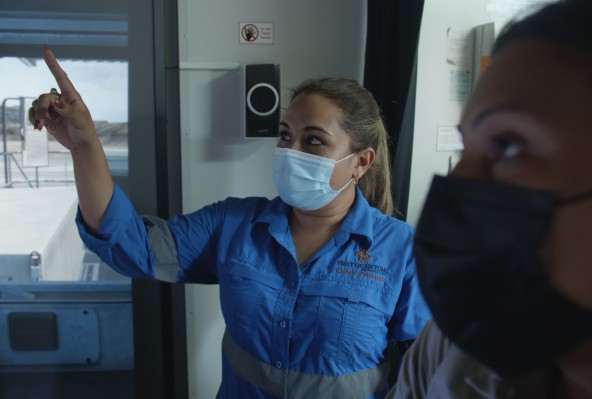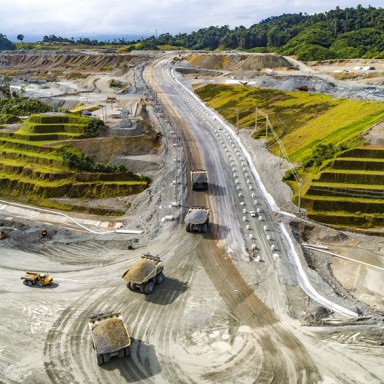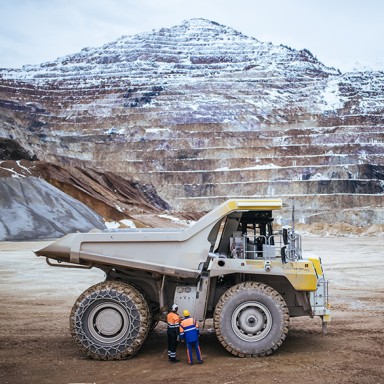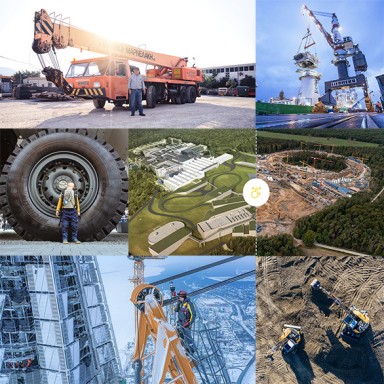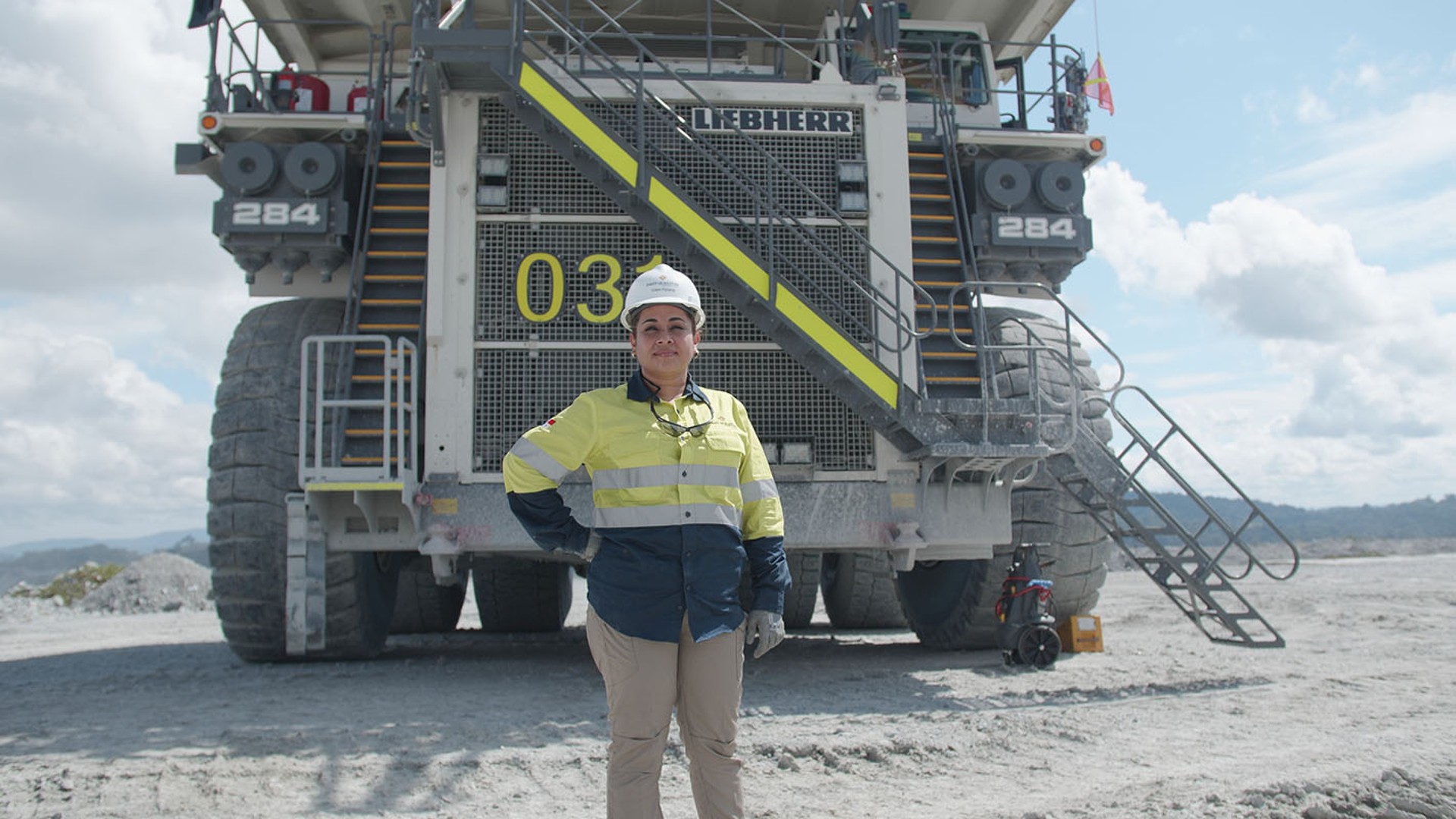
Dream big. Work hard. Make it happen.
As the first woman to drive the biggest mining truck in Panama and an instructor for the Liebherr T 284, Nancy Lazo shows her colleagues how it’s done.
A dream come true
About three stories high and capable of loading the equivalent of 26 school busses – no, this isn’t a riddle but rather a Liebherr T 284 truck, the workplace of Panamanian miner Nancy Lazo. The young woman standing before us at the site of Cobre Panamá has an impressive record: she was one of the first women in Panama to sit in the driver’s seat of a Liebherr T 284. Today, she also trains her mostly male colleagues how to operate the colossal mining trucks. “I am very proud to be the first female heavy equipment operator here in Panama. It is one of my greatest successes,” Lazo says.
By clicking on “ACCEPT”, you consent to the data transmission to Google for this video pursuant to Art. 6 para. 1 point a GDPR. If you do not want to consent to each YouTube video individually in the future and want to be able to load them without this blocker, you can also select “Always accept YouTube videos” and thus also consent to the respectively associated data transmissions to Google for all other YouTube videos that you will access on our website in the future.
You can withdraw given consents at any time with effect for the future and thus prevent the further transmission of your data by deselecting the respective service under “Miscellaneous services (optional)” in the settings (later also accessible via the “Privacy Settings” in the footer of our website).
For further information, please refer to our Data Protection Declaration and the Google Privacy Policy.*Google Ireland Limited, Gordon House, Barrow Street, Dublin 4, Ireland; parent company: Google LLC, 1600 Amphitheatre Parkway, Mountain View, CA 94043, USA** Note: The data transfer to the USA associated with the data transmission to Google takes place on the basis of the European Commission’s adequacy decision of 10 July 2023 (EU-U.S. Data Privacy Framework).I am very proud to be the first female heavy equipment operator here in Panama. It is one of my greatest successes.
For some, becoming a woman in mining, a field still dominated by men, as well as an instructor, might seem an unusual career choice. For Nancy Lazo, it is where her passions have taken her. “It all started when I saw the machinery being taken to the mine,” she explains. After attending courses at INADEH, the National Institute of Professional Training for Human Development, the now 30-year-old was hired by First Quantum Minerals (FQML), proprietor of Cobre Panamá. Starting as an operator, she soon began to drive bigger machines and finally became the operator of the biggest mining truck in Panama. In 2018 she was given the opportunity to extend her field to become an instructor. “It was obvious from the start that Nancy had a lot of determination. She was very clear about what she wanted to do, which was operating the biggest trucks in the world,” says Edwin Salazar, Mining Production Manager at Cobre Panamá. “But we could see early on that she had great talent for passing on what she had learned. That’s a rare gift because you may be a very good operator, but that does not mean you’re a good teacher,” he adds. For Lazo, joining the instructors meant fulfilling another dream: “Both my parents are teachers and I had always wanted to become one too,” she says.
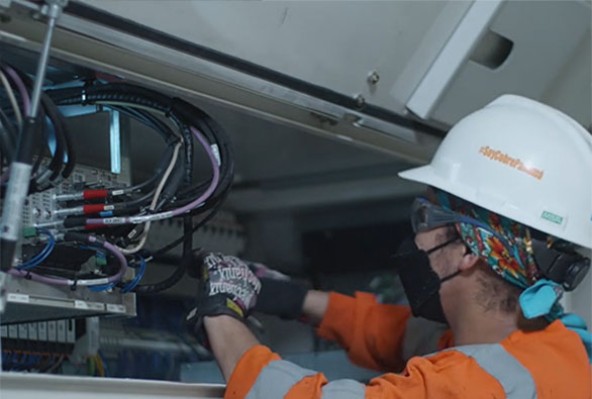
Working in a male dominant industry
The fact that she would have to instruct mostly male colleagues was not a daunting task to Lazo. “My colleagues always treated me with respect,” she says, “that did not change when I started training them. Sure, our interactions might be less relaxed when I’m teaching but that is because I sometimes have to call them to attention, it’s not because they are challenging me.” Something similar happened to one of Nancy’s female colleagues, Ladyn Correa, the only female electrical technician working on the trucks. “There is a lot of respect in the team. They respect my position and my work. I work shoulder to shoulder with them,” explained Correa. Still, with gender roles as they are, both of their paths were not without challenges. “Sometimes it was difficult to really become part of a group that used to think heavy equipment is only for men. There were situations where I felt I had to give it more and keep trying and trying to be accepted and also to do well,” Lazo explains. Today, however, she feels most of her colleagues are proud of her progress and are happy to be taught by her. And this is well-deserved. “She's one of our top instructors for the Ultra Class Liebherr trucks T 284,” confirms Salazar.
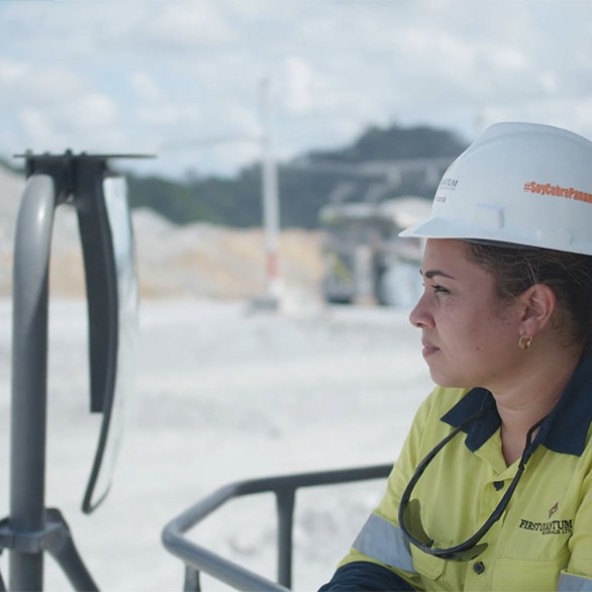
Mastering control of the giants
For Nancy the fascination of driving and training in a fully loaded 600-tonne-truck hasn’t worn off. “I love it!” she exclaims. Most of her time is spent teaching the theoretical background, “but whenever I’m in one of the DTU (Detachable Towing Unit) trucks with one of my students or when I operate them myself, I still feel just as excited as I did the first time,” Lazo adds. Small wonder as every day may pose a new challenge. “The coolest part is that you can never be certain what is going to happen. Here in Panama the weather is very volatile, and we often have to handle the equipment in extreme conditions,” she explains, “and that’s not easy at all and takes a lot of concentration. But to me it is the most beautiful part, because there is always something new, something different in these trucks on a daily basis”.
The memory of my grandmother is also what drives me because she didn't believe that I could achieve this dream.
Family matters
Mother to a teenage son, Nancy Lazo is glad that the equipment she works with is becoming more sustainable. Family, in general, and the strong women surrounding her in particular play an important role in her life. “My mom is my motivation, my pillar. She is the person who always pushes me forward and does not let me fall. And my grandmother, who sadly is no longer with us, always took care of me. Her memory is also what drives me because she was one of the people who believed that I could not achieve this dream.” Her mother also was the one who taught her how to drive a car when she was only 16 years old. “My dad just didn’t have the patience,” Lazo laughs. Being away from her family over extended periods of time is the only downside of her job - a situation that has been exacerbated due to the COVID-19 pandemic. “For the past five years I have had to leave home many times which is difficult because my son is still growing up. Luckily, my parents are there to support us,” she adds. “Sometimes I feel a bit torn between home and the mine where I’m able to do such fascinating work.”
By clicking on “ACCEPT”, you consent to the data transmission to Google for this video pursuant to Art. 6 para. 1 point a GDPR. If you do not want to consent to each YouTube video individually in the future and want to be able to load them without this blocker, you can also select “Always accept YouTube videos” and thus also consent to the respectively associated data transmissions to Google for all other YouTube videos that you will access on our website in the future.
You can withdraw given consents at any time with effect for the future and thus prevent the further transmission of your data by deselecting the respective service under “Miscellaneous services (optional)” in the settings (later also accessible via the “Privacy Settings” in the footer of our website).
For further information, please refer to our Data Protection Declaration and the Google Privacy Policy.*Google Ireland Limited, Gordon House, Barrow Street, Dublin 4, Ireland; parent company: Google LLC, 1600 Amphitheatre Parkway, Mountain View, CA 94043, USA** Note: The data transfer to the USA associated with the data transmission to Google takes place on the basis of the European Commission’s adequacy decision of 10 July 2023 (EU-U.S. Data Privacy Framework).Dream team of the future
Since Liebherr Mining offers a range of future-ready solutions, it was the first choice for First Quantum Minerals. “We are a company at the forefront of technology and that's why we chose Liebherr technology,” explains Salazar. FQML is convinced there is no better match for Cobre Panamá in terms of productivity, efficiency, and sustainability. The support offered by Liebherr is a further selling point: “We had to make a number of adaptations when we received the trucks in order to integrate them. All those challenges were overcome and the fleet is running perfectly today,” he explains. To date, the collaboration has been so successful that a further eight T 284 trucks have been ordered for the mine. “We are a world leader in copper exports. And in order to be a world leader, we have to work with state-of-the-art technology,” says Salazar. “That's why we wanted to work with Liebherr, because we know that they also work with state-of-the-art technology.”
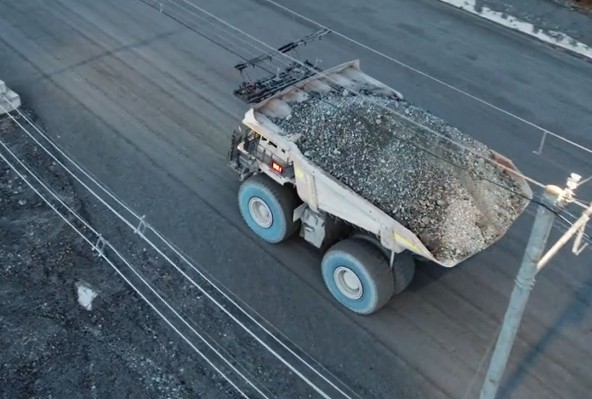
Contributing to zero emission mining
The innovative Liebherr solution enables customers to fulfil their goals in reducing CO2 emissions. Enrique Fals, who works in product support for Liebherr, has been monitoring the Cobre Panamá fleet in order to provide feedback and ensure maintenance work is done according to the manual. As he works on site, he has direct insight into the effectiveness of the system. “The data we have gathered here shows two important things have been achieved. Firstly, that we are able to significantly reduce pollution given that we can save about 91 percent of fuel. Secondly, the truck can go faster when connected to the Trolley System. Normally a loaded truck has a speed of 13 kilometres per hour but with the Trolley System the speed of a loaded truck uphill can be up to 22 kilometres per hour.” Both factors improve the duty cycle of the trucks enabling mining companies to maximise their return on investment and to meet production targets with fewer trucks, or in shorter timeframes.
An important metal
Lazo is not alone in this. Overall, there are more than 700 women miners working at Cobre Panamá. The mine is the largest em-ployer in the region: “We provide work for more than 4,500 Panamanians as well as over 1,850 suppliers,” explains Edwin Salazar. Copper is needed for numerous applications in the industrial, technology, and automotive sectors. The metal and its alloys especially play a significant role in energy transition. Both electric vehicles (EVs) and battery storage technology heavily rely on the metal. According to the IEA, copper will remain the most widely used metal in renewable energy technologies.
Digging deeper in Panama
Women represent an estimated 8 to 17 percent of the global mining workforce. Local statistics are hard to come by but in recent years, mining in Panama has experienced a strong push. Currently, Panama’s economy is primarily based on the services sector which accounts for about 80 percent of the gross domestic product (GDP). While the Panama Canal is the largest economic contributor, mining is also a key economic driver. Reports claim that by 2023, mining activity is expected to contribute to about 10 percent of GDP. “Today, Cobre Panamá exports represent four percent of the Panamanian GDP,” says Salazar. The growing industry will also provide opportunities for female miners. Cobre Panamá which started commercial production in 2019, will produce more than 300,000 tonnes of copper per year along with gold, silver, and molybdenum once it runs at full capacity.


